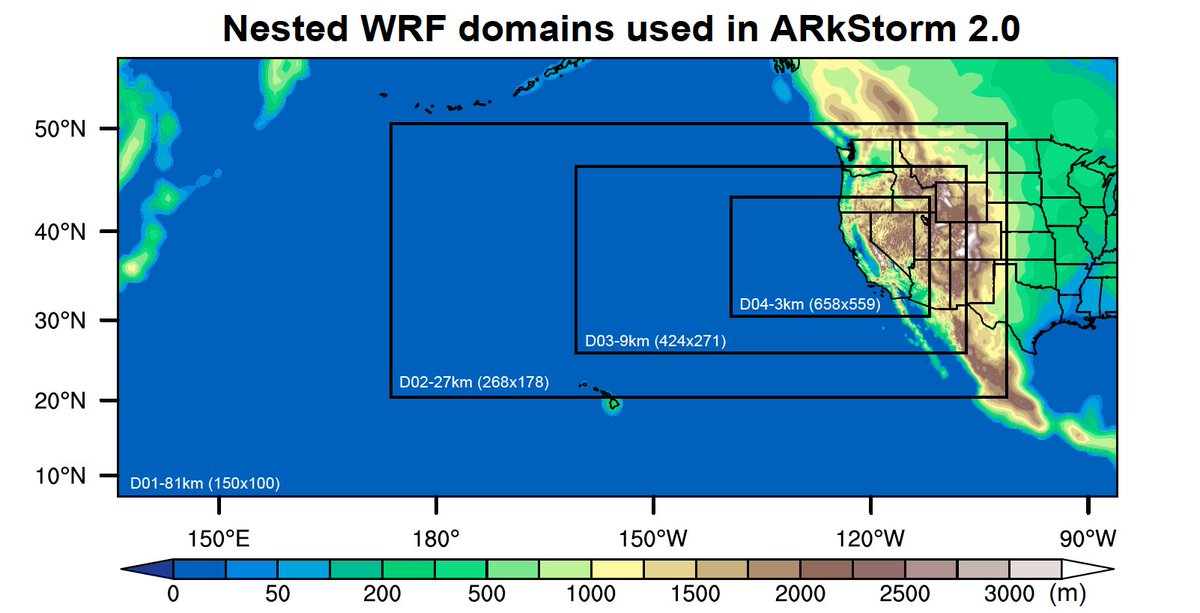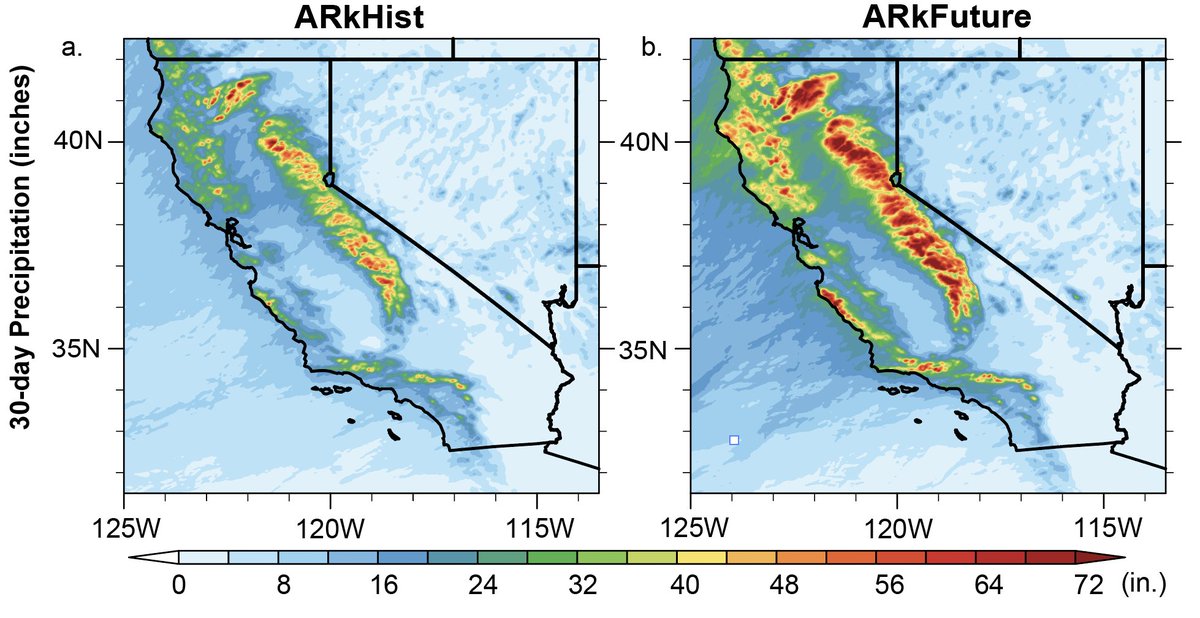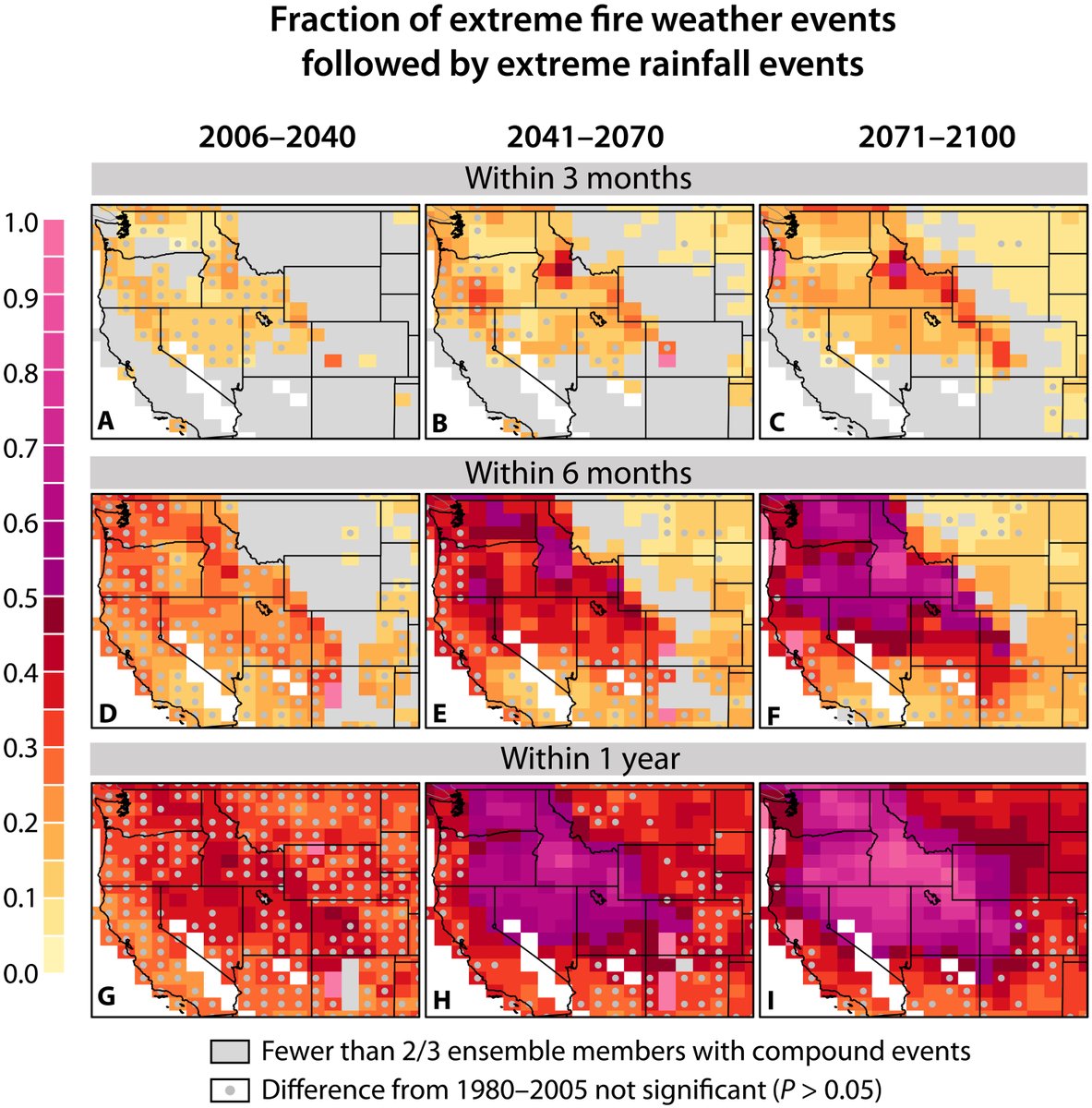
New work co-led by @xingyhuang and me on the rising risk of a California #megaflood due to #ClimateChange is out today in @ScienceAdvances! This paper also describes the new #ARkStorm2 scenarios in detail, & will be the basis for ongoing work. (Thread:1/n) science.org/doi/10.1126/sc…
For context: the work and findings presented here represent the first phase of the broader #ARkStorm2 project, a multi-year, cross-institutional effort involving multiple @UofCalifornia campuses, @DRIScience, @USGS, @CA_DWR, & @NCAR_Science. (2/n) science.org/doi/10.1126/sc…
In this work, we develop a pair of plausible extreme, month-long winter storm sequences in California--one from the recent historical climate, and one from a much warmer future climate. These sequences involve a multi-week series of successive #AtmosphericRiver storms. (3/n) 

These scenarios are drawn from a climate model large ensemble (CESM-LENS), using a high-resolution weather model (WRF) embedded within climate model conditions to produce realistic "synthetic weather forecasts" in present and future climates. #CAwx science.org/doi/10.1126/sc… (4/n) 

Both ARkHist & ARkFuture generate huge amounts of precipitation in California, but ARkFuture scenario is considerably wetter (45% so on a statewide basis, & locally 80% wetter). Some mountain areas see 30-day precip >60 inches in ARkHist, and >100 inches in ARkFuture! (5/n) 

Interestingly, we find larger increases in daily/ hourly precipitation *intensities* than in overall amounts--suggesting that risk of flash flooding in smaller watersheds/urban areas, as well as debris flows, might increase more than river flood risk in warming climate. (6/n) 

We also find dramatic changes in rain/snow balance in California's mountains during ARkFuture--in which most precip falls as rain (vs snow) at elevations as high as 5-6,000 feet. This has enormous implications for hydrology of watersheds draining historical snowsheds. (7/n) 

Subsequently, we find very large increases in peak runoff during ARkFuture vs ARkHist: 60-100% higher statewide & locally 3-400% higher in Sacramento & (especially) San Joaquin basins as more precip falls overall & much greater fraction falls as rain.science.org/doi/10.1126/sc… (8/n) 

We also consider the large-scale conditions that coincide with simulated California megafloods. Intriguingly, 8 of the 8 top events in present and future climates occur during warm ENSO (#ElNiño) conditions, and 7/8 during moderate to strong events. (9/n) science.org/doi/10.1126/sc… 

Further, few if any of these #ElNiño events are east-based: they have a more Central Pacific focus (so-called #ElNiño Modoki). This has a couple of important implications... (10/n) science.org/doi/10.1126/sc…
First, it means that there may be seasonal predictability of risk--since there's a strong tilt toward moderate-strong #ElNiño years. Second, megafloods are more likely to occur in years with wet antecedent conditions--amplifying flood risk. (11/n) science.org/doi/10.1126/sc…
We also consider the role of #ClimateChange in increasing the risk of California megafloods. Large pluvials have, of course, occurred in California since time immemorial. But we find that climate change is sharply upping the odds. (12/n) #CAwx science.org/doi/10.1126/sc…
We find that #ClimateChange has already doubled the risk of a California megaflood (since 1920). Each half of a degree of additional global warming will lead to appreciable further increases in risk moving forward through the 21st century. #CAflood science.org/doi/10.1126/sc… (13/n) 

It may seem a bit strange to be talking about rising risk of a California #megaflood amidst severe #CAdrought. But it's not as paradoxical as it might seem at first glance--a topic I discuss extensively in my new Weather West overview of our work: (14/n) weatherwest.com/archives/16626
Collectively, all of this suggests that California really needs to be planning for an increasing risk of catastrophic flooding--risk that was widely underestimated even absent climate change, but now those risks are rising further. (15/n) science.org/doi/10.1126/sc…
This research has been literally years in the making, & involved a tremendous amount of effort on the part of co-lead author @xingyhuang, who actually implemented all of the lengthy atmospheric simulations described in this work as a (very involved) side project! (16/n)
This paper, and indeed the entirety of the ongoing #ARkStorm2 project, would not have been possible without Xingying's dedicated efforts over several years.
I would also like to acknowledge the entities and institutions that made our work possible. @UCLAIoES, @Conserve_CA, and @C3WE_NCAR continue to support my overall efforts, and @CA_DWR and @YubaWater both provided funding specifically for the research discussed in this paper.
I also want to thank the numerous other #ARkStorm2 collaborators whose conversations over the past few years shaped the scenario design and experiments, especially including: @dalecox, Maureen McCarthy, Christine Albano, Mike Anderson, @KathyQ100lady, Kristin Ludwig, & Anne Wein.
Finally, I plan to host my first-ever live @TwitterSpaces event to have an interactive discussion of this paper, its results and implications, and #ARkStorm2 more broadly this coming Monday, Aug 15. Stay tuned for a link this weekend! (20/end)
• • •
Missing some Tweet in this thread? You can try to
force a refresh











